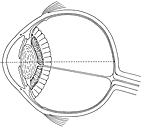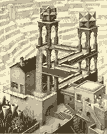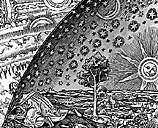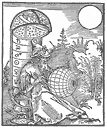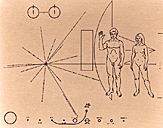The apparatus of sight
Now that cameras are so commonplace it would be unlikely to find anyone unfamiliar with the basic model for how the eye works to focus incoming light through its lens onto the retina which is like a thin coating of photosensitive cells on the rear of the eyeball (fig i). The retina is connected to the brain by the optic nerve. This apparatus is constantly moving and re-sampling information of different kinds from the environment. Just where and how the visual impressions that comprise the sense of what we call sight become part of an individual’s awareness is still not clear to us. What we think is that to make sense of what we see requires interaction with our intelligence.
Seeing is an interpretive process
As we all know from looking at optical illusions the perceptual and cognitive apparatus through which our mind/body observes and makes meaning of the world is not without its flaws, ambiguities and distortions. There are links to a number of web sites featuring optical illusions in the left hand panel of this page. Some optical illusions highlight the difficulties that are inherent in translating the 3-dimensional space in which we live into two dimensions. Some illusions demonstrate phenomena attributable to cognitive adjustments that we all make when interpreting visual clues about orientation. Some illusions are believed to trick our detection of colour and or tonal differences, some interfere with the afterimages produced in our optical nervous system, and some happen because the constant movements our eyes make between selective and peripheral vision are interfered with. Others are to do with how we interpret shapes, patterns and comparative tonality. People from diverse cultures may observe the effects of these illusions. This fact highlights that these illusions resulting from physical and psychological aberrations are to do with the way humans are “wired” rather than resulting from learning and conditioning.
Unlike other aspects of visual culture, the effects of such illusions do not arise out of the actuality of socially shared understandings, or ‘culture’. Indeed, they tend to highlight the fallibility of our sensory and perceptual faculties. The existence of these paradoxes highlights some of the issues that may become problematic if we were to try to establish that it is possible to achieve a purely empirical, scientifically objective way of viewing and visually representing the world. This is obviously not the case and the first thing we need to understand about seeing, especially in relation to the practice of drawing, is that seeing is an interpretive process. The inconstancy of vision is highlighted even more when cultural and emotional influences are considered. The artist M.C. Escher is renowned for challenging our culturally learned prejudices (fig ii).
Visual thinking
The first of the recommended readings for this week is a discussion concerning aspects of perception, which have traditionally been thought of as to do with how we gather sensory information, and aspects of cognition, which have traditionally been thought of as how we process this information, cannot be separated. The author, Rudolf Arnheim, a Professor of Psychology of Art, contends in his book Visual Thinking that all thinking is perceptual in nature. In the chapter selected, The Intelligence of Visual Perception (i) he analyses aspects of visual perception. He outlines his belief that interpretive intelligence is necessary for visual processing and judgment of factors concerning:
• separation of objects from ground
• discernment of depth
• shapes as concepts
• the importance of time and the persistence of vision
• completing details from memory
• the importance of context
• brightness, sharpness and texture.
Interestingly, these qualities may be mapped to those that we will be considering as important in understanding key principles related to drawing, namely: line, shape, depth, pattern and continuity, surface, tonality, brightness and contrast.
Arnheim also introduces in this chapter other concepts that are significant as we begin to think about how we see and relate these thoughts to how we represent what we see during the process of drawing:
• the selectiveness of vision (how we fix and focus on details)
• the specialisation of parts of the sensory apparatus (e.g. rods and cones in the retina involved in the perception of colour)
• the significance of peripheral vision (for spatial reading and for movement detection).
Worldview and point-of-view
Before we continue, let’s take a moment to think about our viewing space. If you wear spectacles, please remove them and put them somewhere safe for the moment. Sitting in a chair with a back, sit up straight resting your back in the chair so that your head is quite still, take deep breaths, relax and look straight ahead. Look as far into the distance as you can, even if you cannot focus on anything there. Then move your eyes around the extreme periphery of your vision a couple of times. Blink if you have to and relax with a focus in the middle distance straight ahead. Keeping your eyes wide open and your head still, look now wherever you want. Concentrate on exploring the space before you with your eyes. The details of what you actually see are unimportant. The objects before you are not significant. Now describe, making a mental note or expressing out loud, the space that you are viewing. There is no right or wrong answer to this simple exercise.
Some people may experience and describe the viewing space before them as a hemisphere. Some may see it as more of a flat kind of rectangular space with fuzzy corners. Some may think of it as a horizontal cone extending infinitely out from their point-of-view. Others may find that their observation and impression of the space itself changes or jumps around as they move their eyes. Indeed, one’s impression of one’s field of view and viewing space may vary depending on the environment that one is in. For example your impression inside a room where the walls are relatively close and there are corners, skirting and cornices forming part of your view is likely to be quite different from if you are outside in an expansive environment and surrounded by organic and seemingly random forms. If there is much movement around you your impression may be different from a situation of relative calm.
One thing is for sure, the way you describe that space in front of you is going to be influenced by your worldview or in other words, your understanding of the world. One’s interpretation of point-of-view and viewing space is unavoidably conditioned by cultural factors. Point-of-view is not a fixed quality. It may be influenced by learning other ways of seeing and by understanding differently the relationships between things in time and space. Fig iii is an illustration representing how one may have conceived the world in times before Copernicus (1473-1543) challenged the orthodox view that the firmament revolved around the Earth. Using this example we can see that point-of-view is relative to culturally derived actuality, that is to say, it is conditioned by one’s knowledge and understanding of the world.
Seeing involves culturally learned prejudices
Another example may be demonstrated if we look at the Dűrer woodcut of the astronomer at fig iv. We can see that there is man seated holding a globe and apparently measuring it with dividers. Beyond is a natural landscape the most dominant feature of which is the full moon in the sky.
The moon in this picture is an example of a representational symbol. The white circular shape is visually suggestive of the moon but is very simplified with no detail. The mechanical looking device appears to be a planetarium. It is inscribed with astrological symbols. It is quite possible that the meaning of these is not accessible to all who view this image. They are examples of a special class of symbol called signs. Signs are understood only by agreement or convention. Signs generally do not convey any suggestive visual characteristics relating to what they stand for. These particular signs are representative of planets and are still used today, however, unless you are engaged with astrology you could be forgiven for being ignorant of this. You may even have attributed contemporary meanings to a sign that you thought you recognized, such as the symbol commonly used to represent a female (also the sign for Venus). In this case you may have attributed meaning unintended by the artist.
This woodcut image has another level of symbolism at work. The attire of the bearded gentleman is likely to have cultural significance totally lost to a present day audience. The most we may make of it is that it is not of our time. Yet in Dűrer’s time the clothes probably denoted considerable information about the man’s social standing.
Scientific understanding influences the contemporary worldview. If a being from the future or an alien culture were to have to reconstruct this worldview based on remnant visual artifacts it is quite conceivable that they may view as quite paradoxical the mathematically justified, perspective-based constructions used in some 3D computer games that seem realistic to contemporary eyes (fig v). This paradox was in the minds of those commissioned to produce the artwork for the plaques secured to the Pioneer 10 and 11 spacecraft launched in 1972 and 1973 and which are intended to travel out into space beyond our solar system, possibly to be discovered by an interstellar neighbour (see fig vi).
In another sense quite different sense, point-of-view may also be relative to phenomenological context. It is relative to one’s physical location with respect to the objects of focus in front of and around oneself. It is relative to one’s movement in space and time.
Indeed, when it comes to representing on paper what one sees in reality or in one’s imagination, an experienced visualiser may actually choose specific or even multiple points-of-view and relational systems to achieve certain representational, evocative or stylistic ends. Thus point-of-view as represented by an artist can also be consciously influenced by intent.
In the coming weeks we will be looking at representational systems. We will see that when considered historically the development of drawing systems can appear to be a kind of evolution. However, the prevailing post-modern attitude does not privilege one mode over another. Rather we tend to recognise each mode as distinct in its original cultural context. When considering examples from history full appreciation of the context may no longer be possible. The relevant symbolic information significant to conveyance of meaning, otherwise known as semantics, may have been lost over time. Still we can study such examples as technical constructions and formal representations insofar as we can make sense of the forms and spatial relationships.
Visualisation and Illustration as professional communication
Technology is associated with a constant spawning of new ways to measure, observe and represent the world. One of the advantages that drawing and illustration, as communication channels provide over more technologically based and automated channels of representation, is the ability to control the elements that are synthesized to make meaning in an interpretive and purposeful way.
When drawing and visualising we are concerned with form and with spatial arrangement, with tonality and texture and so on. We do our best to organise and control these qualities in order to satisfy a communicative intent. It should be clear by definition that the act of communication requires someone to receive the communication. This person will actively construct or synthesise meaning, bringing with them to this task their own intentions, experience and culture.
In the context of this unit and its focus on professional communication the primary consideration at the outset should be:
• what is the purpose of the drawing? Identify a clear intention (what is it that this drawing is to communicate, and to whom?)
Secondary considerations will then be to:
• establish a point-of-view and spatial scheme appropriate to the task,
• consider the relationships between things and how you will represent them,
• consider how much embellishment will be necessary to achieve the intention (keep it as simple as possible),
• consider how to avoid unintended visual ambiguity and aberration.
As we progress through this unit, we will be looking at topics which will assist you in thinking about these aspects of your visual thinking and communication.
References
Arnheim, R., (2004) Visual Thinking, Uni of Cal Press
Tufte, E. R., (1997) Visual Explanations: Images and Quantities, Evidence and Narrative, Graphic Press
